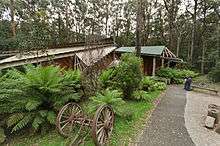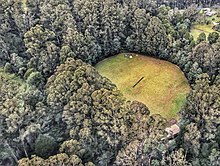Toolangi, Victoria
Toolangi is a rural township in Victoria, Australia. At the 2016 census, Toolangi and the surrounding area had a population of 344.[1] It is situated on the edge of the Toolangi State Forest.
| Toolangi Victoria | |||||||||||||||
|---|---|---|---|---|---|---|---|---|---|---|---|---|---|---|---|
 Toolangi | |||||||||||||||
| Coordinates | 37°32′S 145°28′E | ||||||||||||||
| Population | 344 (2016 census)[1] | ||||||||||||||
| Postcode(s) | 3777 | ||||||||||||||
| Location |
| ||||||||||||||
| LGA(s) | Shire of Murrindindi | ||||||||||||||
| State electorate(s) | Eildon | ||||||||||||||
| Federal Division(s) | Indi | ||||||||||||||
| |||||||||||||||
| |||||||||||||||
History

The name Toolangi is an Aboriginal word meaning tall trees or stringy bark.[2] It is believed the area was known as Mt Rose by European settlers up until the 1890s. European settlers was first inhabited Toolangi in the 1860s by paling splitters and then timber cutters, who camped deep in the bush. They were attracted by the huge stands of mountain ash (Eucalyptus regnans), a tree that splits easily, and the messmate timber, which proved durable as a building material.
Toolangi Post Office opened on 1 August 1900 and closed in 1974.[3]
It was not until the early 1960s that electricity came to Toolangi. Together with the opening of the Melba Highway, this created the impetus for industrial expansion in the area. An early development was the Potato Research Station (1945), which was followed by the Strawberry Certification Scheme.[4]
On 7 February 2009, the Black Saturday bushfires reached Toolangi and led to two deaths and 18 homes burnt. Fire surrounded the town for weeks and the whole area was quarantined for three weeks. The township itself and a small segment of forest in the Toolangi State Forest to the east of the town survived.
Attractions

A strangely-shaped wooden building surrounded by tall eucalypts is visible when driving through the town. This is the former Toolangi Forest Discovery Centre. This building was used for forest education, and thousands of primary, secondary and tertiary students visited every year. The Discovery Centre and education programs was run by the Department of Sustainability and Environment (DSE), however it was closed on 30 June 2012 due to difficulty in compliance with building requirements in bushfire-prone areas. With endorsement from DSE, long time environmental education specialists Gould League now conduct the same forest education programs, with previous DSE staff, simply without the use of the building.


There are several local walking tracks, which are detailed in information available at the centre, including the Wirra Willa Rain forest walk through local rainforest, the Yea River Walk opposite the centre, and the Forest Sculpture Trail, which takes in nine works by sculptors of international repute and views both of Melbourne and the district. Mount St Leonard is 5 km. to the south-east.
Toolangi was the home of the poet C. J. Dennis, the author of The Songs of a Sentimental Bloke, Jim of the Hills, The Glugs of Gosh, Rose of Spadgers, The Singing Gardens and Ginger Mick, to name a few. Dennis joined artist Hal Waugh on an expedition to Toolangi in 1908. Dennis stayed on after the expedition, attracted by the ambience of the area, he was also a business partner in one of the many sawmills of the area—St Leonards Sawmill. His work captured the feel of the bush and the Australian characters, both of the bush and the pubs. In 1915, he purchased 3.5 acres (14,000 m2) for 22 pounds. This included a mill house. Over a period of 10 years, with the help of a local handyman, they converted the mill house to a two-storey house named "Arden".[4] His house has long since burned down, but his gardens remain in the care of Jan and Vic Williams, where they operate their tea rooms, The Singing Gardens, and are open to the public.
Opposite the gardens is the pottery of David Williams, who creates unique crystalline-glazed ceramics, which have been exhibited in the National Gallery of Victoria.
The former Toolangi Hotel burned to the ground in 1975. While the building was totally destroyed, the locals saved the beer. For weeks afterwards, they would gather under the trees at the old pub site and assist in depleting the stocks. The former licensee decided not to rebuild the pub and the town remained publess for decades.[5]
Climate
Toolangi has an oceanic climate, cooler than Melbourne due to elevation, with annual temperatures resembling Southern England in Europe and the Pacific Northwest in North America more than other Australian climates. It is also very wet by Victorian standards.
| Climate data for Toolangi (1981–2006 normals; extremes 1953–2006) | |||||||||||||
|---|---|---|---|---|---|---|---|---|---|---|---|---|---|
| Month | Jan | Feb | Mar | Apr | May | Jun | Jul | Aug | Sep | Oct | Nov | Dec | Year |
| Record high °C (°F) | 42.0 (107.6) |
38.6 (101.5) |
37.5 (99.5) |
28.0 (82.4) |
21.9 (71.4) |
17.9 (64.2) |
18.5 (65.3) |
19.5 (67.1) |
24.5 (76.1) |
29.7 (85.5) |
34.9 (94.8) |
38.5 (101.3) |
42.0 (107.6) |
| Average high °C (°F) | 22.7 (72.9) |
23.5 (74.3) |
20.3 (68.5) |
16.3 (61.3) |
12.5 (54.5) |
9.6 (49.3) |
8.6 (47.5) |
10.0 (50.0) |
12.4 (54.3) |
15.5 (59.9) |
18.5 (65.3) |
21.0 (69.8) |
15.9 (60.6) |
| Average low °C (°F) | 10.9 (51.6) |
11.8 (53.2) |
10.5 (50.9) |
8.7 (47.7) |
7.0 (44.6) |
4.9 (40.8) |
3.9 (39.0) |
4.2 (39.6) |
5.3 (41.5) |
6.6 (43.9) |
7.8 (46.0) |
9.4 (48.9) |
7.6 (45.7) |
| Record low °C (°F) | 2.7 (36.9) |
3.0 (37.4) |
2.2 (36.0) |
0.5 (32.9) |
−1.0 (30.2) |
−2.2 (28.0) |
−2.5 (27.5) |
−5.0 (23.0) |
−4.1 (24.6) |
−0.6 (30.9) |
0.4 (32.7) |
2.2 (36.0) |
−5.0 (23.0) |
| Average precipitation mm (inches) | 90.2 (3.55) |
69.2 (2.72) |
86.0 (3.39) |
106.3 (4.19) |
103.0 (4.06) |
121.0 (4.76) |
122.9 (4.84) |
135.4 (5.33) |
139.0 (5.47) |
124.7 (4.91) |
120.3 (4.74) |
118.1 (4.65) |
1,335.3 (52.57) |
| Source: [6] | |||||||||||||
References
- "2016 Census QuickStats Toolangi". Australian Bureau of Statistics. Retrieved 13 April 2019.
- "Toolangi". www.vaclang.org.au. Retrieved 25 July 2019.
- Premier Postal History, Post Office List, retrieved 11 April 2008
- THE TOWNSHIP OF TOOLANGI - PAST AND PRESENT collated by Ian Whitford
- https://visityarravalley.com.au/activity/toolangi
- "Climate normals for Toolgani". Bureau of Meteorology. Retrieved 10 March 2018.